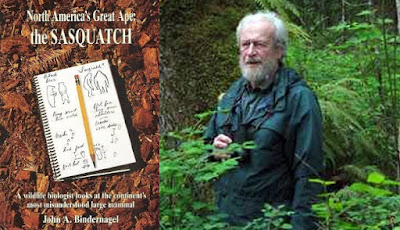Based on its reported food habits, the sasquatch appears to occupy an ecological niche similar to that of the black bear or grizzly bear throughout North America.
The range of food items in the sasquatch diet may exceed that of bears, however, largely because of the sasquatch's behavioral adaptations to predation and its greater hunting and swimming skills. Geza Telecki has proposed that the chimpanzees he studied in Gombe. Tanzania be described as "omnivorous forager-predators"—this description may fit the sasquatch equally well.
Sasquatches may be attitudinally migratory in mountainous environments where seasonally adverse conditions make migration advantageous or necessary. They may, however, be resident in habitats where food is available in sufficient quantities year-round.
Possible Overwintering Strategies
Hibernation and Torpor. Hibernation involves the significant lowering of body temperature and is the mechanism used by ground squirrels to survive the winter in temperate regions. Torpor, the overwintering mechanism used by bears, involves a slightly lowered body temperature. It has been suggested as a possible overwintering strategy for the sasquatch in northern and interior habitats.
According to Chad. Lyman and his colleagues, "the occurrence of torpor in primates appears to be limited to the dwarf lemurs of Madagascar., The authors refer to anecdotal information suggesting that dwarf lemurs may become torpid in especially cold periods during the winter. They note that "in the laboratory, the fat-tailed dwarf lemur was able to increase the amount of fat in its body and enter a torpid state for over a week at a time. They observe, however, that "periods of torpor have not been recorded for other primates and probably do not occur."
These observations suggest that torpor does indeed occur in some primates during cold periods. Whether it occurs in the sasquatch can only be speculated upon at present.
Other Adaptations to Cold.
Other adaptations to cold in primates include the growth of long hair such as that noted by George Schaller for gorillas in cold habitats and by John Napier for Japanese macaques in northern Japan.
A certain amount of adaptation to a cold climate may be inferred from the extreme "hairiness" of most sasquatch. observed. It is possible, however, that this heavy coat renders the animal subject to summer heat stress. The report of the sasquatch sitting at the mouth of an ice cave at the edge of a British Columbia glacier in August, suggests the possibility of summer heat stress being a problem.
Diet, Adaptation to Prolonged Periods of Snow Cover.
The principal dietary adaptation to periods of prolonged deep snow cover may be a shift to a predominantly carnivorous diet. Indeed, most anthropologists accept that meat-eating was a pre-requisite for humans extending their range of occupation into northern latitudes. On the west coast of North America shellfish and other intertidal sources of protein remain available all year It is relatively easy to account for the year round existence of the sasquatch on the west coast where aboriginal people have not only survived but developed rich cultures during centuries of occupation.
It is the overwintering of sasquatches in the northern interior of the continent—Alberta, Manitoba, Ohio and elsewhere—that requires explanation. For these areas we can postulate various scenarios for sasquatch survival and persistence. These include foraging on small mammals such as squirrels in nests, other rodents in logs and rock piles, and predation on rabbits, deer, and elk. In winter, it is almost certain that sasquatches rely increasingly on a meat diet, with or without periods of torpor or reliance on stored food.
Buy the book: "North America's Great Ape: The Sasquatch" here.



No comments:
Post a Comment